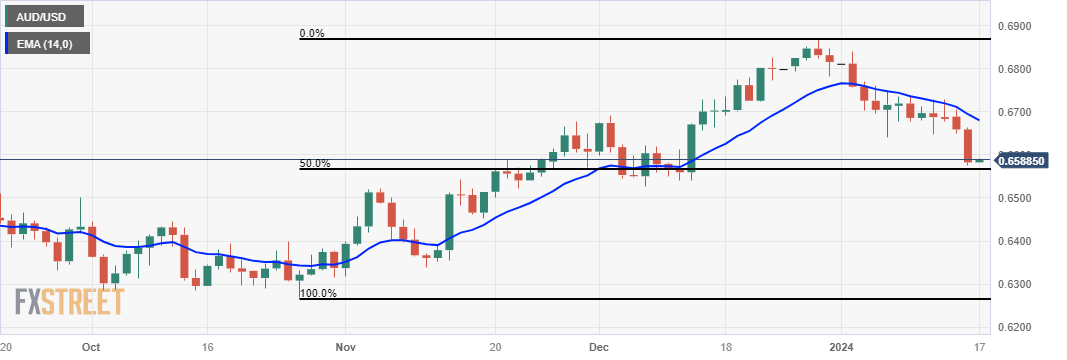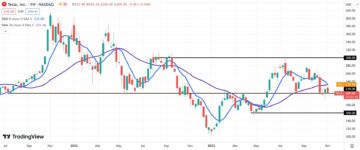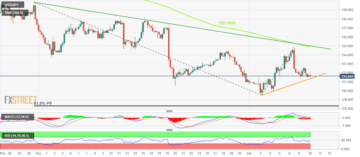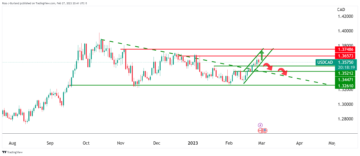- Australian Dollar faced challenges on improved US Dollar amid market caution.
- Australian central bank is expected to refrain from increasing interest rates, influenced by lower consumer confidence in January.
- The decline in commodity prices contributed to downward pressure on the AUD.
- China’s annual GDP grew by 5.2%, slightly lower than the 5.3% expected in the fourth quarter.
- Upbeat US Treasury yields contributed to supporting the Greenback.
The Australian Dollar (AUD) continues its losing streak on Wednesday, struggling to find stability against the US Dollar (USD). In the previous session, the AUD/USD pair experienced a decline, influenced by a stronger Greenback, driven by upbeat US Treasury yields. Market participants have reduced their speculation on rate cuts from the US Federal Reserve (Fed). Heightened tensions in the Middle East conflict have also contributed to investor caution. Additionally, a decline in commodity prices, potentially reflecting fears of weaker demand from China, has weighed on the Aussie Dollar (AUD).
Australia’s Consumer Confidence data for January showed a contraction which has contributed to the sentiment that there might not be further policy tightening from the Reserve Bank of Australia (RBA) in its upcoming board meeting in February. This perception, in turn, is putting pressure on the AUD/USD pair.
China’s annual Gross Domestic Product (GDP) grew by 5.2% against the 5.3% expected in the fourth quarter. December’s Industrial Production (YoY) increased by 6.8%. which was expected to remain consistent at 6.6%. Retail Sales year-over-year came at 7.4%, falling short of the market consensus of 8.0%.
Chinese consumer prices experienced a third consecutive month of decline in December, and producer prices also saw a decrease. This suggests persistent deflationary cost pressures in the country. However, in a speech delivered at the World Economic Forum in Davos, Premier Li Qiang stated on Tuesday that China’s economy grew by approximately 5.2% in 2023. This growth rate is slightly better than the official target set by Beijing
The US Dollar Index (DXY) seems to continue its four-day winning streak, supported by recent remarks from Federal Reserve officials. Fed Governor Christopher Waller cautioned that, despite positive developments in the inflation outlook, the central bank is not rushing to outline plans for rate cuts.
Atlanta Fed President Raphael Bostic also suggested over the weekend that premature interest rate cuts could lead to inflation fluctuations. Bostic emphasized that the deceleration of inflation towards the central bank’s 2.0% target was expected to slow down in the coming months.
US NY Empire State Manufacturing Index saw a significant decline, dropping to 43.7 in January, well below the expected decrease of 5. Traders will likely monitor the upcoming US Retail Sales data for December. The expectation is for a slight growth in retail sales which could provide insights into consumer spending patterns.
Daily Digest Market Movers: Australian Dollar declines on improved US Dollar
- Australian TD Securities inflation increased by 5.2% YoY in December from 4.4% in November.
- Australia’s job advertisements improved by 0.1% in December, swinging from the previous decline of 4.6%.
- People’s Bank of China (PBoC) maintained the rate on its medium-term facility steady at 2.5%, increasing the expectation that the Reserve Requirement Ratio will be reduced the following month.
- Chinese Consumer Price Index (YoY) decreased by 0.3% in December, against the expected 0.4% decline. The monthly Consumer Price Index eased to 0.1%, compared to the market expectation of 0.2%. The yearly Producer Price Index fell by 2.7%, slightly exceeding the expected decline of 2.6%.
- Barclays revised its forecast for the first Federal Reserve (Fed) rate cut on Friday, moving it to March from June. In a note released on Friday, Barclays analysts expressed their expectation for the Federal Open Market Committee (FOMC) to reduce the Fed Funds rate by 25 basis points at the March meeting.
- US Bureau of Labor Statistics reported that the December Producer Price Index (PPI) figure was 1.0% year-on-year, compared to the previous reading of 0.8%. The Core PPI YoY arrived at 1.8%, down from 2.0% in November. Monthly, the headline and Core PPI indices remained flat at -0.1% and 0.0%, respectively.
- US Bureau of Labor Statistics reported that the Consumer Price Index (CPI) surged to 3.4% YoY in December, exceeding both November’s 3.1% and the anticipated market figure of 3.2%. The monthly CPI growth for December showed a 0.3% increase, surpassing the market analysts’ estimated projection of 0.2%. The annual Core CPI stood at 3.9%, a slight decrease from November’s 4.0%, while the monthly figure remained steady at 0.3%, in line with expectations.
Technical Analysis: Australian Dollar edges lower to near 0.6550
The Australian Dollar traded near 0.6590 on Wednesday followed by the immediate psychological resistance level at 0.6600. A break above the barrier could push the AUD/USD pair to approach the major level at 0.6650 following the 14-day Exponential Moving Average (EMA) at 0.6680 and the psychological level at 0.6700. On the downside, the 50% retracement level at 0.6566 could act as a key support level followed by the major support at 0.6550.
AUD/USD: Daily Chart
Australian Dollar price today
The table below shows the percentage change of Australian Dollar (AUD) against listed major currencies today. Australian Dollar was the weakest against the US Dollar.
| USD | EUR | GBP | CAD | AUD | JPY | NZD | CHF | |
| USD | 0.14% | 0.22% | 0.18% | 0.49% | 0.32% | 0.29% | 0.09% | |
| EUR | -0.14% | 0.10% | 0.04% | 0.39% | 0.19% | 0.16% | -0.05% | |
| GBP | -0.22% | -0.10% | -0.06% | 0.26% | 0.09% | 0.05% | -0.14% | |
| CAD | -0.18% | -0.04% | 0.05% | 0.35% | 0.14% | 0.10% | -0.11% | |
| AUD | -0.49% | -0.35% | -0.24% | -0.31% | -0.16% | -0.20% | -0.40% | |
| JPY | -0.33% | -0.17% | -0.09% | -0.16% | 0.17% | -0.05% | -0.23% | |
| NZD | -0.29% | -0.14% | -0.05% | -0.11% | 0.21% | 0.03% | -0.19% | |
| CHF | -0.09% | 0.05% | 0.16% | 0.10% | 0.44% | 0.24% | 0.20% |
The heat map shows percentage changes of major currencies against each other. The base currency is picked from the left column, while the quote currency is picked from the top row. For example, if you pick the Euro from the left column and move along the horizontal line to the Japanese Yen, the percentage change displayed in the box will represent EUR (base)/JPY (quote).
Australian Dollar FAQs
One of the most significant factors for the Australian Dollar (AUD) is the level of interest rates set by the Reserve Bank of Australia (RBA). Because Australia is a resource-rich country another key driver is the price of its biggest export, Iron Ore. The health of the Chinese economy, its largest trading partner, is a factor, as well as inflation in Australia, its growth rate and Trade Balance. Market sentiment – whether investors are taking on more risky assets (risk-on) or seeking safe-havens (risk-off) – is also a factor, with risk-on positive for AUD.
The Reserve Bank of Australia (RBA) influences the Australian Dollar (AUD) by setting the level of interest rates that Australian banks can lend to each other. This influences the level of interest rates in the economy as a whole. The main goal of the RBA is to maintain a stable inflation rate of 2-3% by adjusting interest rates up or down. Relatively high interest rates compared to other major central banks support the AUD, and the opposite for relatively low. The RBA can also use quantitative easing and tightening to influence credit conditions, with the former AUD-negative and the latter AUD-positive.
China is Australia’s largest trading partner so the health of the Chinese economy is a major influence on the value of the Australian Dollar (AUD). When the Chinese economy is doing well it purchases more raw materials, goods and services from Australia, lifting demand for the AUD, and pushing up its value. The opposite is the case when the Chinese economy is not growing as fast as expected. Positive or negative surprises in Chinese growth data, therefore, often have a direct impact on the Australian Dollar and its pairs.
Iron Ore is Australia’s largest export, accounting for $118 billion a year according to data from 2021, with China as its primary destination. The price of Iron Ore, therefore, can be a driver of the Australian Dollar. Generally, if the price of Iron Ore rises, AUD also goes up, as aggregate demand for the currency increases. The opposite is the case if the price of Iron Ore falls. Higher Iron Ore prices also tend to result in a greater likelihood of a positive Trade Balance for Australia, which is also positive of the AUD.
The Trade Balance, which is the difference between what a country earns from its exports versus what it pays for its imports, is another factor that can influence the value of the Australian Dollar. If Australia produces highly sought after exports, then its currency will gain in value purely from the surplus demand created from foreign buyers seeking to purchase its exports versus what it spends to purchase imports. Therefore, a positive net Trade Balance strengthens the AUD, with the opposite effect if the Trade Balance is negative.
- SEO Powered Content & PR Distribution. Get Amplified Today.
- PlatoData.Network Vertical Generative Ai. Empower Yourself. Access Here.
- PlatoAiStream. Web3 Intelligence. Knowledge Amplified. Access Here.
- PlatoESG. Carbon, CleanTech, Energy, Environment, Solar, Waste Management. Access Here.
- PlatoHealth. Biotech and Clinical Trials Intelligence. Access Here.
- Source: https://www.fxstreet.com/news/australian-dollar-hovers-below-a-psychological-level-after-mixed-chinese-data-202401170215
- :has
- :is
- :not
- $UP
- 1
- 2%
- 2021
- 2023
- 25
- 32
- 35%
- 36
- 41
- 50
- 7
- 8
- a
- above
- According
- Accounting
- Act
- Additionally
- adjusting
- After
- against
- aggregate
- ahead
- along
- also
- Amid
- analysis
- Analysts
- and
- Animate
- annual
- Another
- Anticipated
- approach
- approximately
- ARE
- arrived
- AS
- Assets
- At
- AUD
- AUD/USD
- aussie
- Australia
- Australian
- Australian dollar
- average
- Balance
- Bank
- Bank of China
- Banks
- Barclays
- barrier
- base
- basis
- BE
- because
- below
- Better
- between
- Biggest
- Billion
- board
- both
- Box
- Break
- Bureau
- bureau of labor statistics
- buyers
- by
- came
- CAN
- case
- caution
- central
- Central Bank
- Central Banks
- challenges
- change
- Changes
- China
- chinese
- Christopher
- Christopher Waller
- Column
- coming
- committee
- commodity
- commodity prices
- compared
- conditions
- confidence
- conflict
- consecutive
- Consensus
- consistent
- consumer
- consumer price index
- content
- continues
- contributed
- Core
- Cost
- could
- country
- CPI
- created
- credit
- currencies
- Currency
- Cut
- cuts
- daily
- data
- davos
- December
- Decline
- Declines
- decrease
- decreased
- deflationary
- delivered
- Demand
- Despite
- destination
- developments
- difference
- Digest
- direct
- displayed
- doing
- Dollar
- dollar index
- Domestic
- down
- downside
- downward
- driven
- driver
- Dropping
- Dxy
- each
- easing
- East
- Economic
- Economic Forum
- economy
- economy grew
- edges
- effect
- EMA
- emphasized
- Empire
- ends
- estimated
- EUR
- Euro
- example
- expanded
- expectation
- expectations
- expected
- experienced
- exponential
- exponential moving average
- export
- exports
- expressed
- faced
- Facility
- factor
- factors
- Falling
- falling short
- Falls
- FAQ
- FAST
- fears
- February
- Fed
- fed funds rate
- Federal
- Federal Open Market Committee
- federal reserve
- Figure
- First
- flat
- fluctuations
- followed
- following
- FOMC
- For
- Forecast
- foreign
- Former
- Forum
- Fourth
- Friday
- from
- from 2021
- funds
- further
- Gain
- GDP
- generally
- goal
- Goes
- goods
- Governor
- greater
- Greenback
- grew
- Growing
- Growth
- Have
- headline
- Health
- heightened
- High
- higher
- highly
- Horizontal
- However
- HTTPS
- if
- immediate
- Impact
- imports
- improved
- in
- Increase
- increased
- Increases
- increasing
- index
- Indices
- industrial
- Industrial Production
- inflation
- inflation rate
- influence
- influenced
- insights
- interest
- INTEREST RATE
- Interest Rates
- into
- investor
- Investors
- IT
- ITS
- January
- Japanese
- Japanese Yen
- Job
- june
- Key
- labor
- largest
- lead
- left
- LEND
- Level
- li
- lifting
- likelihood
- likely
- Line
- Listed
- losing
- Low
- lower
- Main
- maintain
- maintained
- major
- manufacturing
- map
- March
- Market
- market sentiment
- materials
- meeting
- Middle
- Middle East
- might
- module
- Monitor
- Month
- monthly
- months
- more
- most
- move
- Movers
- moving
- moving average
- Near
- negative
- net
- note
- November
- NY
- of
- official
- officials
- often
- on
- open
- opposite
- or
- Other
- outline
- Outlook
- over
- pair
- pairs
- participants
- partner
- patterns
- pays
- PBOC
- percentage
- perception
- pick
- picked
- plans
- plato
- Plato Data Intelligence
- PlatoData
- points
- policy
- positive
- potentially
- ppi
- Premature
- premier
- president
- pressure
- pressures
- previous
- price
- Prices
- primary
- producer
- produces
- Production
- Projection
- provide
- psychological
- purchase
- purchases
- purely
- Push
- Pushing
- Putting
- quantitative
- Quantitative Easing
- Quarter
- quote
- Rate
- Rates
- ratio
- Raw
- RBA
- Reading
- recent
- reduce
- Reduced
- reflecting
- relatively
- released
- remain
- remained
- Reported
- represent
- requirement
- Reserve
- reserve bank
- reserve bank of australia
- Reserve Bank of Australia (RBA)
- Resistance
- result
- retail
- Retail Sales
- retracement
- Rises
- Risky
- ROW
- s
- sales
- saw
- Securities
- seeking
- seems
- sentiment
- Services
- session
- set
- setting
- Short
- showed
- Shows
- significant
- slow
- So
- sought
- speculation
- speech
- Spending
- Stability
- stable
- starts
- State
- stated
- statistics
- steady
- stood
- Strengthens
- stronger
- Struggling
- Suggests
- support
- support level
- Supported
- Supporting
- Surged
- surpassing
- surplus
- surprises
- table
- taking
- Target
- TD
- TD Securities
- tensions
- than
- that
- The
- the Fed
- The US Federal Reserve
- the world
- their
- then
- There.
- therefore
- Third
- this
- tightening
- to
- today
- top
- towards
- trade
- Traders
- Trading
- treasury
- Treasury yields
- Tuesday
- TURN
- upbeat
- upcoming
- us
- US Dollar
- US Dollar Index
- US Federal
- us federal reserve
- US Retail Sales
- US Treasury
- US treasury yields
- USD
- use
- value
- Versus
- was
- Wednesday
- weekend
- WELL
- What
- when
- whether
- which
- while
- whole
- will
- winning
- with
- world
- World Economic Forum
- year
- yearly
- Yen
- yields
- you
- zephyrnet













